AFA3202 Financial Management Report: UniSuper and Investment Choices
VerifiedAdded on 2022/12/13
|7
|2013
|153
Report
AI Summary
This report provides an in-depth analysis of financial management, specifically focusing on superannuation and retirement plans within the Australian context. It explores the importance of financial planning, particularly concerning retirement savings, and examines the roles of both employers and employees in managing these plans. The report delves into the specifics of UniSuper, a prominent industry-based superannuation fund, and compares and contrasts the Defined Benefit Plan and the Investment Choice Plan, considering factors such as risk, investment returns, and time value of money. Furthermore, it discusses various retirement products offered by UniSuper, including indexed pensions and assigned pension schemes, along with rollover alternatives and part-payment distribution options. The report also includes calculations to estimate the future value of pension investments, providing a practical understanding of financial planning for retirement. It concludes with a summary of key findings and references to relevant literature.

Financial Management
Paraphrase This Document
Need a fresh take? Get an instant paraphrase of this document with our AI Paraphraser
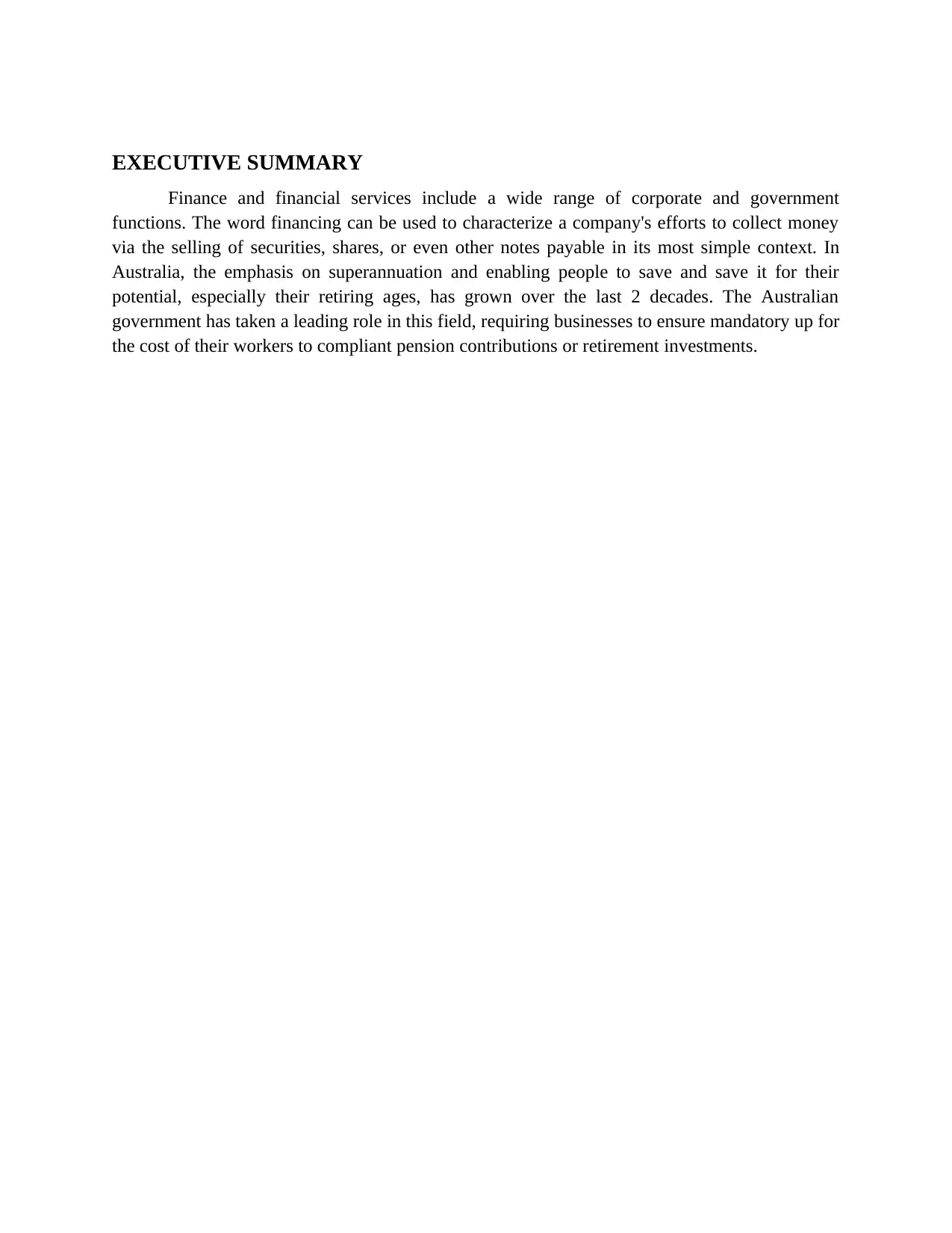
EXECUTIVE SUMMARY
Finance and financial services include a wide range of corporate and government
functions. The word financing can be used to characterize a company's efforts to collect money
via the selling of securities, shares, or even other notes payable in its most simple context. In
Australia, the emphasis on superannuation and enabling people to save and save it for their
potential, especially their retiring ages, has grown over the last 2 decades. The Australian
government has taken a leading role in this field, requiring businesses to ensure mandatory up for
the cost of their workers to compliant pension contributions or retirement investments.
Finance and financial services include a wide range of corporate and government
functions. The word financing can be used to characterize a company's efforts to collect money
via the selling of securities, shares, or even other notes payable in its most simple context. In
Australia, the emphasis on superannuation and enabling people to save and save it for their
potential, especially their retiring ages, has grown over the last 2 decades. The Australian
government has taken a leading role in this field, requiring businesses to ensure mandatory up for
the cost of their workers to compliant pension contributions or retirement investments.
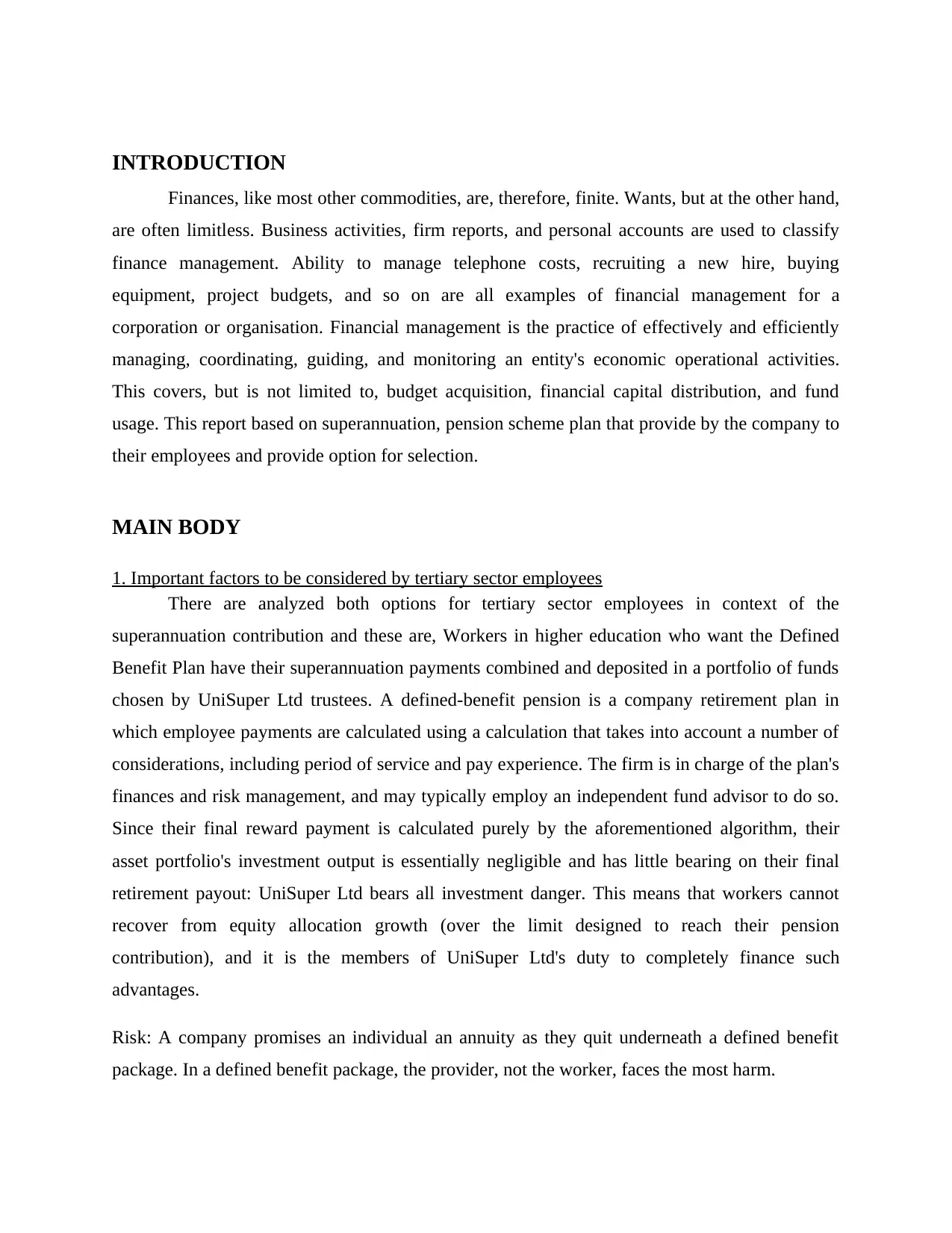
INTRODUCTION
Finances, like most other commodities, are, therefore, finite. Wants, but at the other hand,
are often limitless. Business activities, firm reports, and personal accounts are used to classify
finance management. Ability to manage telephone costs, recruiting a new hire, buying
equipment, project budgets, and so on are all examples of financial management for a
corporation or organisation. Financial management is the practice of effectively and efficiently
managing, coordinating, guiding, and monitoring an entity's economic operational activities.
This covers, but is not limited to, budget acquisition, financial capital distribution, and fund
usage. This report based on superannuation, pension scheme plan that provide by the company to
their employees and provide option for selection.
MAIN BODY
1. Important factors to be considered by tertiary sector employees
There are analyzed both options for tertiary sector employees in context of the
superannuation contribution and these are, Workers in higher education who want the Defined
Benefit Plan have their superannuation payments combined and deposited in a portfolio of funds
chosen by UniSuper Ltd trustees. A defined-benefit pension is a company retirement plan in
which employee payments are calculated using a calculation that takes into account a number of
considerations, including period of service and pay experience. The firm is in charge of the plan's
finances and risk management, and may typically employ an independent fund advisor to do so.
Since their final reward payment is calculated purely by the aforementioned algorithm, their
asset portfolio's investment output is essentially negligible and has little bearing on their final
retirement payout: UniSuper Ltd bears all investment danger. This means that workers cannot
recover from equity allocation growth (over the limit designed to reach their pension
contribution), and it is the members of UniSuper Ltd's duty to completely finance such
advantages.
Risk: A company promises an individual an annuity as they quit underneath a defined benefit
package. In a defined benefit package, the provider, not the worker, faces the most harm.
Finances, like most other commodities, are, therefore, finite. Wants, but at the other hand,
are often limitless. Business activities, firm reports, and personal accounts are used to classify
finance management. Ability to manage telephone costs, recruiting a new hire, buying
equipment, project budgets, and so on are all examples of financial management for a
corporation or organisation. Financial management is the practice of effectively and efficiently
managing, coordinating, guiding, and monitoring an entity's economic operational activities.
This covers, but is not limited to, budget acquisition, financial capital distribution, and fund
usage. This report based on superannuation, pension scheme plan that provide by the company to
their employees and provide option for selection.
MAIN BODY
1. Important factors to be considered by tertiary sector employees
There are analyzed both options for tertiary sector employees in context of the
superannuation contribution and these are, Workers in higher education who want the Defined
Benefit Plan have their superannuation payments combined and deposited in a portfolio of funds
chosen by UniSuper Ltd trustees. A defined-benefit pension is a company retirement plan in
which employee payments are calculated using a calculation that takes into account a number of
considerations, including period of service and pay experience. The firm is in charge of the plan's
finances and risk management, and may typically employ an independent fund advisor to do so.
Since their final reward payment is calculated purely by the aforementioned algorithm, their
asset portfolio's investment output is essentially negligible and has little bearing on their final
retirement payout: UniSuper Ltd bears all investment danger. This means that workers cannot
recover from equity allocation growth (over the limit designed to reach their pension
contribution), and it is the members of UniSuper Ltd's duty to completely finance such
advantages.
Risk: A company promises an individual an annuity as they quit underneath a defined benefit
package. In a defined benefit package, the provider, not the worker, faces the most harm.
⊘ This is a preview!⊘
Do you want full access?
Subscribe today to unlock all pages.

Trusted by 1+ million students worldwide
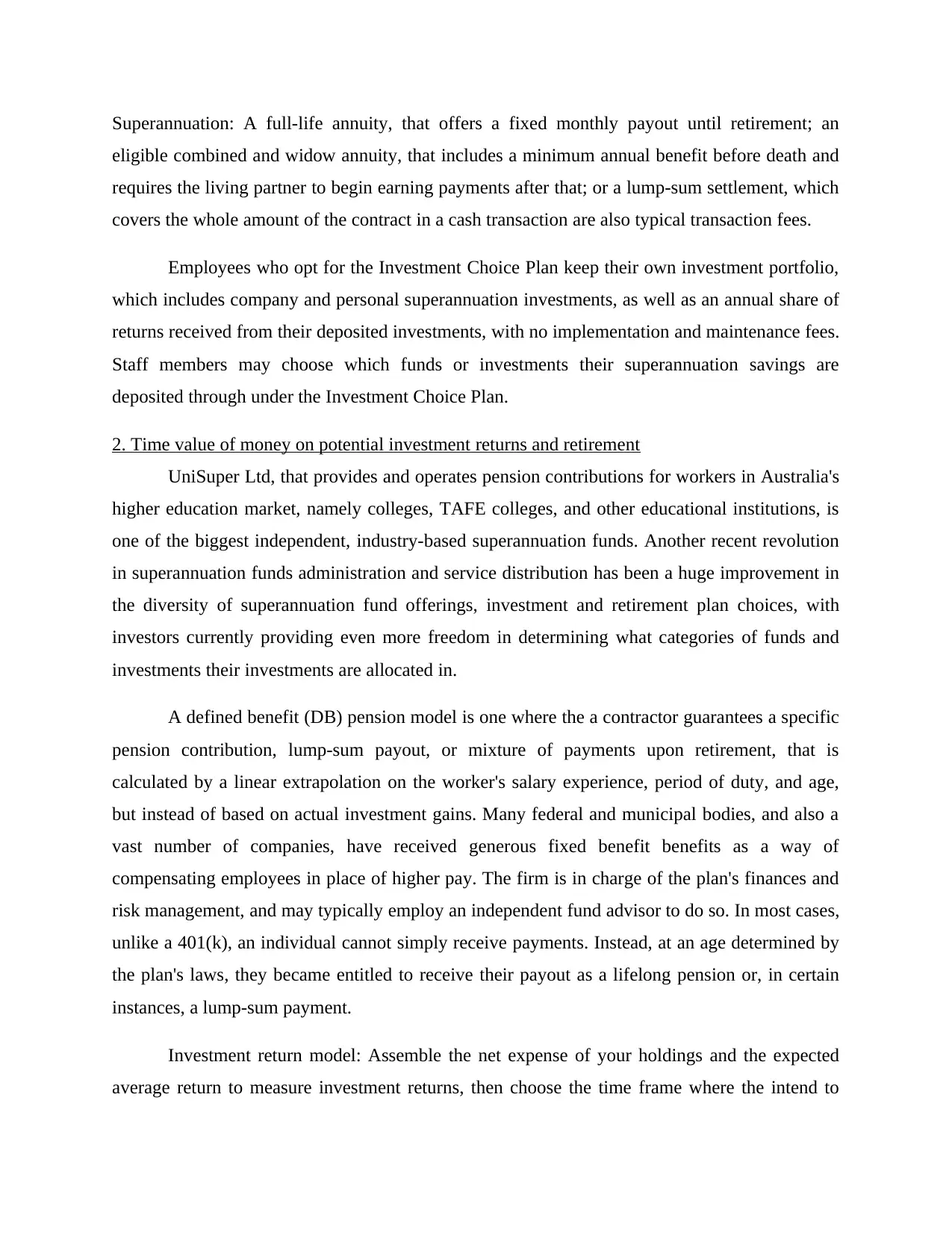
Superannuation: A full-life annuity, that offers a fixed monthly payout until retirement; an
eligible combined and widow annuity, that includes a minimum annual benefit before death and
requires the living partner to begin earning payments after that; or a lump-sum settlement, which
covers the whole amount of the contract in a cash transaction are also typical transaction fees.
Employees who opt for the Investment Choice Plan keep their own investment portfolio,
which includes company and personal superannuation investments, as well as an annual share of
returns received from their deposited investments, with no implementation and maintenance fees.
Staff members may choose which funds or investments their superannuation savings are
deposited through under the Investment Choice Plan.
2. Time value of money on potential investment returns and retirement
UniSuper Ltd, that provides and operates pension contributions for workers in Australia's
higher education market, namely colleges, TAFE colleges, and other educational institutions, is
one of the biggest independent, industry-based superannuation funds. Another recent revolution
in superannuation funds administration and service distribution has been a huge improvement in
the diversity of superannuation fund offerings, investment and retirement plan choices, with
investors currently providing even more freedom in determining what categories of funds and
investments their investments are allocated in.
A defined benefit (DB) pension model is one where the a contractor guarantees a specific
pension contribution, lump-sum payout, or mixture of payments upon retirement, that is
calculated by a linear extrapolation on the worker's salary experience, period of duty, and age,
but instead of based on actual investment gains. Many federal and municipal bodies, and also a
vast number of companies, have received generous fixed benefit benefits as a way of
compensating employees in place of higher pay. The firm is in charge of the plan's finances and
risk management, and may typically employ an independent fund advisor to do so. In most cases,
unlike a 401(k), an individual cannot simply receive payments. Instead, at an age determined by
the plan's laws, they became entitled to receive their payout as a lifelong pension or, in certain
instances, a lump-sum payment.
Investment return model: Assemble the net expense of your holdings and the expected
average return to measure investment returns, then choose the time frame where the intend to
eligible combined and widow annuity, that includes a minimum annual benefit before death and
requires the living partner to begin earning payments after that; or a lump-sum settlement, which
covers the whole amount of the contract in a cash transaction are also typical transaction fees.
Employees who opt for the Investment Choice Plan keep their own investment portfolio,
which includes company and personal superannuation investments, as well as an annual share of
returns received from their deposited investments, with no implementation and maintenance fees.
Staff members may choose which funds or investments their superannuation savings are
deposited through under the Investment Choice Plan.
2. Time value of money on potential investment returns and retirement
UniSuper Ltd, that provides and operates pension contributions for workers in Australia's
higher education market, namely colleges, TAFE colleges, and other educational institutions, is
one of the biggest independent, industry-based superannuation funds. Another recent revolution
in superannuation funds administration and service distribution has been a huge improvement in
the diversity of superannuation fund offerings, investment and retirement plan choices, with
investors currently providing even more freedom in determining what categories of funds and
investments their investments are allocated in.
A defined benefit (DB) pension model is one where the a contractor guarantees a specific
pension contribution, lump-sum payout, or mixture of payments upon retirement, that is
calculated by a linear extrapolation on the worker's salary experience, period of duty, and age,
but instead of based on actual investment gains. Many federal and municipal bodies, and also a
vast number of companies, have received generous fixed benefit benefits as a way of
compensating employees in place of higher pay. The firm is in charge of the plan's finances and
risk management, and may typically employ an independent fund advisor to do so. In most cases,
unlike a 401(k), an individual cannot simply receive payments. Instead, at an age determined by
the plan's laws, they became entitled to receive their payout as a lifelong pension or, in certain
instances, a lump-sum payment.
Investment return model: Assemble the net expense of your holdings and the expected
average return to measure investment returns, then choose the time frame where the intend to
Paraphrase This Document
Need a fresh take? Get an instant paraphrase of this document with our AI Paraphraser
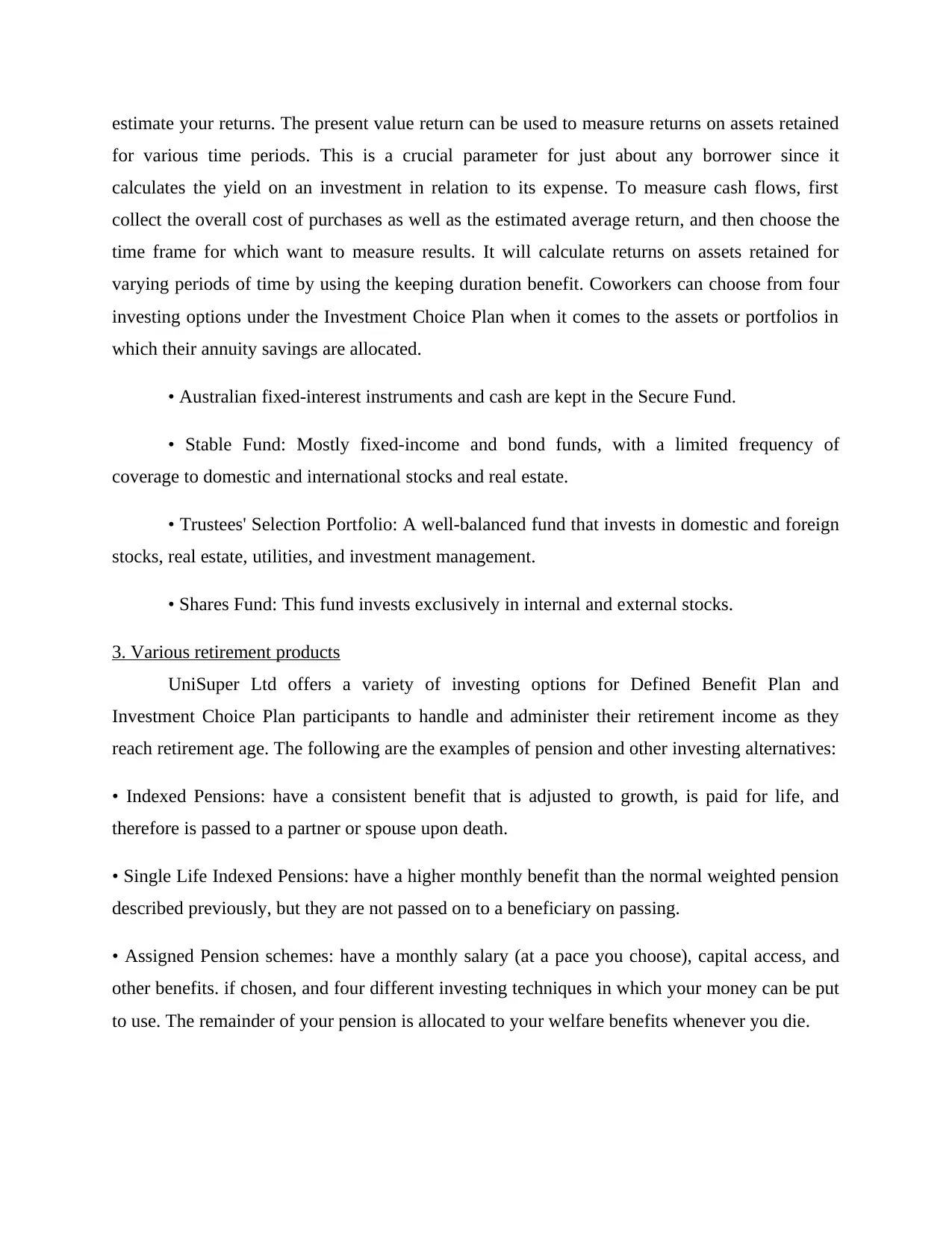
estimate your returns. The present value return can be used to measure returns on assets retained
for various time periods. This is a crucial parameter for just about any borrower since it
calculates the yield on an investment in relation to its expense. To measure cash flows, first
collect the overall cost of purchases as well as the estimated average return, and then choose the
time frame for which want to measure results. It will calculate returns on assets retained for
varying periods of time by using the keeping duration benefit. Coworkers can choose from four
investing options under the Investment Choice Plan when it comes to the assets or portfolios in
which their annuity savings are allocated.
• Australian fixed-interest instruments and cash are kept in the Secure Fund.
• Stable Fund: Mostly fixed-income and bond funds, with a limited frequency of
coverage to domestic and international stocks and real estate.
• Trustees' Selection Portfolio: A well-balanced fund that invests in domestic and foreign
stocks, real estate, utilities, and investment management.
• Shares Fund: This fund invests exclusively in internal and external stocks.
3. Various retirement products
UniSuper Ltd offers a variety of investing options for Defined Benefit Plan and
Investment Choice Plan participants to handle and administer their retirement income as they
reach retirement age. The following are the examples of pension and other investing alternatives:
• Indexed Pensions: have a consistent benefit that is adjusted to growth, is paid for life, and
therefore is passed to a partner or spouse upon death.
• Single Life Indexed Pensions: have a higher monthly benefit than the normal weighted pension
described previously, but they are not passed on to a beneficiary on passing.
• Assigned Pension schemes: have a monthly salary (at a pace you choose), capital access, and
other benefits. if chosen, and four different investing techniques in which your money can be put
to use. The remainder of your pension is allocated to your welfare benefits whenever you die.
for various time periods. This is a crucial parameter for just about any borrower since it
calculates the yield on an investment in relation to its expense. To measure cash flows, first
collect the overall cost of purchases as well as the estimated average return, and then choose the
time frame for which want to measure results. It will calculate returns on assets retained for
varying periods of time by using the keeping duration benefit. Coworkers can choose from four
investing options under the Investment Choice Plan when it comes to the assets or portfolios in
which their annuity savings are allocated.
• Australian fixed-interest instruments and cash are kept in the Secure Fund.
• Stable Fund: Mostly fixed-income and bond funds, with a limited frequency of
coverage to domestic and international stocks and real estate.
• Trustees' Selection Portfolio: A well-balanced fund that invests in domestic and foreign
stocks, real estate, utilities, and investment management.
• Shares Fund: This fund invests exclusively in internal and external stocks.
3. Various retirement products
UniSuper Ltd offers a variety of investing options for Defined Benefit Plan and
Investment Choice Plan participants to handle and administer their retirement income as they
reach retirement age. The following are the examples of pension and other investing alternatives:
• Indexed Pensions: have a consistent benefit that is adjusted to growth, is paid for life, and
therefore is passed to a partner or spouse upon death.
• Single Life Indexed Pensions: have a higher monthly benefit than the normal weighted pension
described previously, but they are not passed on to a beneficiary on passing.
• Assigned Pension schemes: have a monthly salary (at a pace you choose), capital access, and
other benefits. if chosen, and four different investing techniques in which your money can be put
to use. The remainder of your pension is allocated to your welfare benefits whenever you die.
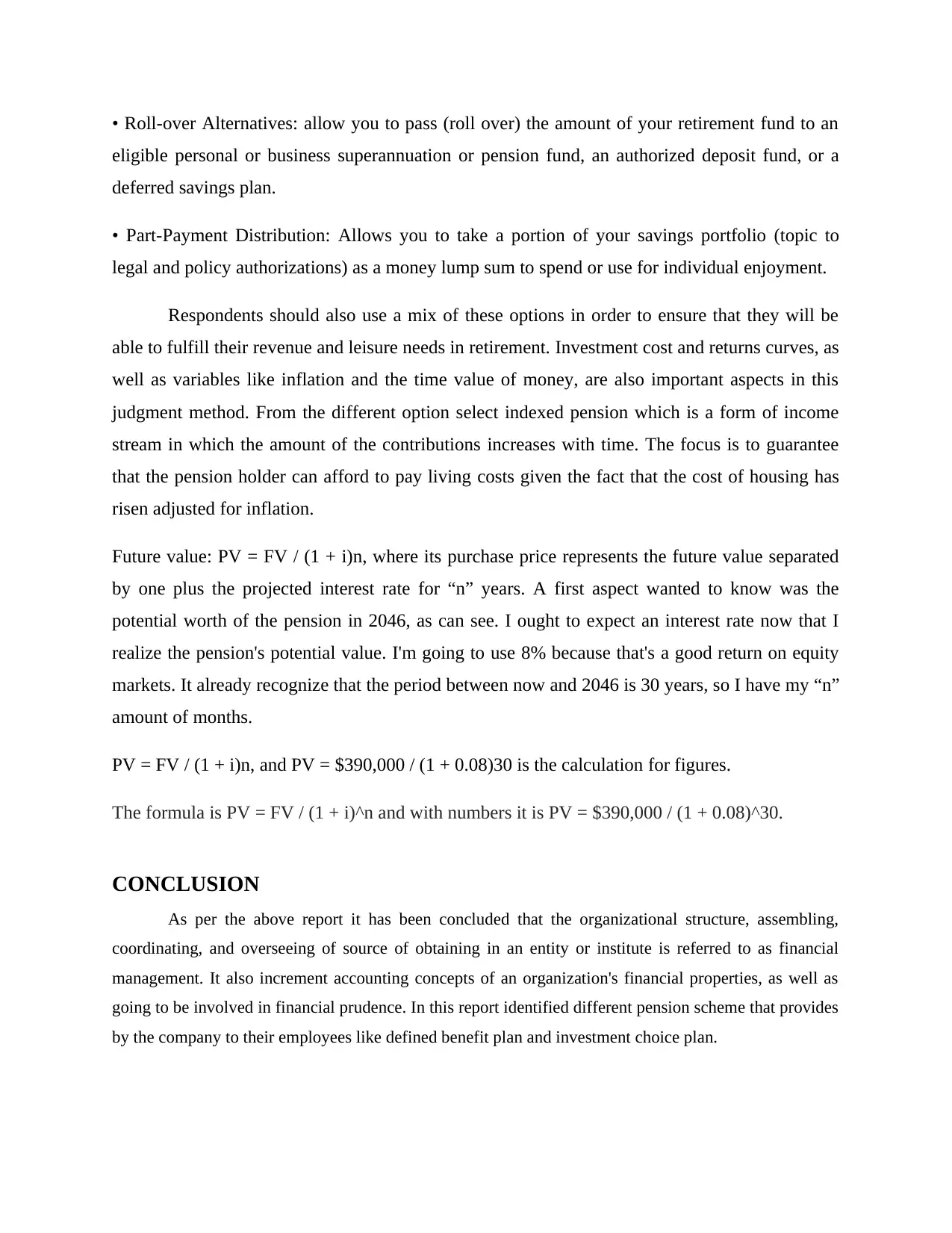
• Roll-over Alternatives: allow you to pass (roll over) the amount of your retirement fund to an
eligible personal or business superannuation or pension fund, an authorized deposit fund, or a
deferred savings plan.
• Part-Payment Distribution: Allows you to take a portion of your savings portfolio (topic to
legal and policy authorizations) as a money lump sum to spend or use for individual enjoyment.
Respondents should also use a mix of these options in order to ensure that they will be
able to fulfill their revenue and leisure needs in retirement. Investment cost and returns curves, as
well as variables like inflation and the time value of money, are also important aspects in this
judgment method. From the different option select indexed pension which is a form of income
stream in which the amount of the contributions increases with time. The focus is to guarantee
that the pension holder can afford to pay living costs given the fact that the cost of housing has
risen adjusted for inflation.
Future value: PV = FV / (1 + i)n, where its purchase price represents the future value separated
by one plus the projected interest rate for “n” years. A first aspect wanted to know was the
potential worth of the pension in 2046, as can see. I ought to expect an interest rate now that I
realize the pension's potential value. I'm going to use 8% because that's a good return on equity
markets. It already recognize that the period between now and 2046 is 30 years, so I have my “n”
amount of months.
PV = FV / (1 + i)n, and PV = $390,000 / (1 + 0.08)30 is the calculation for figures.
The formula is PV = FV / (1 + i)^n and with numbers it is PV = $390,000 / (1 + 0.08)^30.
CONCLUSION
As per the above report it has been concluded that the organizational structure, assembling,
coordinating, and overseeing of source of obtaining in an entity or institute is referred to as financial
management. It also increment accounting concepts of an organization's financial properties, as well as
going to be involved in financial prudence. In this report identified different pension scheme that provides
by the company to their employees like defined benefit plan and investment choice plan.
eligible personal or business superannuation or pension fund, an authorized deposit fund, or a
deferred savings plan.
• Part-Payment Distribution: Allows you to take a portion of your savings portfolio (topic to
legal and policy authorizations) as a money lump sum to spend or use for individual enjoyment.
Respondents should also use a mix of these options in order to ensure that they will be
able to fulfill their revenue and leisure needs in retirement. Investment cost and returns curves, as
well as variables like inflation and the time value of money, are also important aspects in this
judgment method. From the different option select indexed pension which is a form of income
stream in which the amount of the contributions increases with time. The focus is to guarantee
that the pension holder can afford to pay living costs given the fact that the cost of housing has
risen adjusted for inflation.
Future value: PV = FV / (1 + i)n, where its purchase price represents the future value separated
by one plus the projected interest rate for “n” years. A first aspect wanted to know was the
potential worth of the pension in 2046, as can see. I ought to expect an interest rate now that I
realize the pension's potential value. I'm going to use 8% because that's a good return on equity
markets. It already recognize that the period between now and 2046 is 30 years, so I have my “n”
amount of months.
PV = FV / (1 + i)n, and PV = $390,000 / (1 + 0.08)30 is the calculation for figures.
The formula is PV = FV / (1 + i)^n and with numbers it is PV = $390,000 / (1 + 0.08)^30.
CONCLUSION
As per the above report it has been concluded that the organizational structure, assembling,
coordinating, and overseeing of source of obtaining in an entity or institute is referred to as financial
management. It also increment accounting concepts of an organization's financial properties, as well as
going to be involved in financial prudence. In this report identified different pension scheme that provides
by the company to their employees like defined benefit plan and investment choice plan.
⊘ This is a preview!⊘
Do you want full access?
Subscribe today to unlock all pages.

Trusted by 1+ million students worldwide
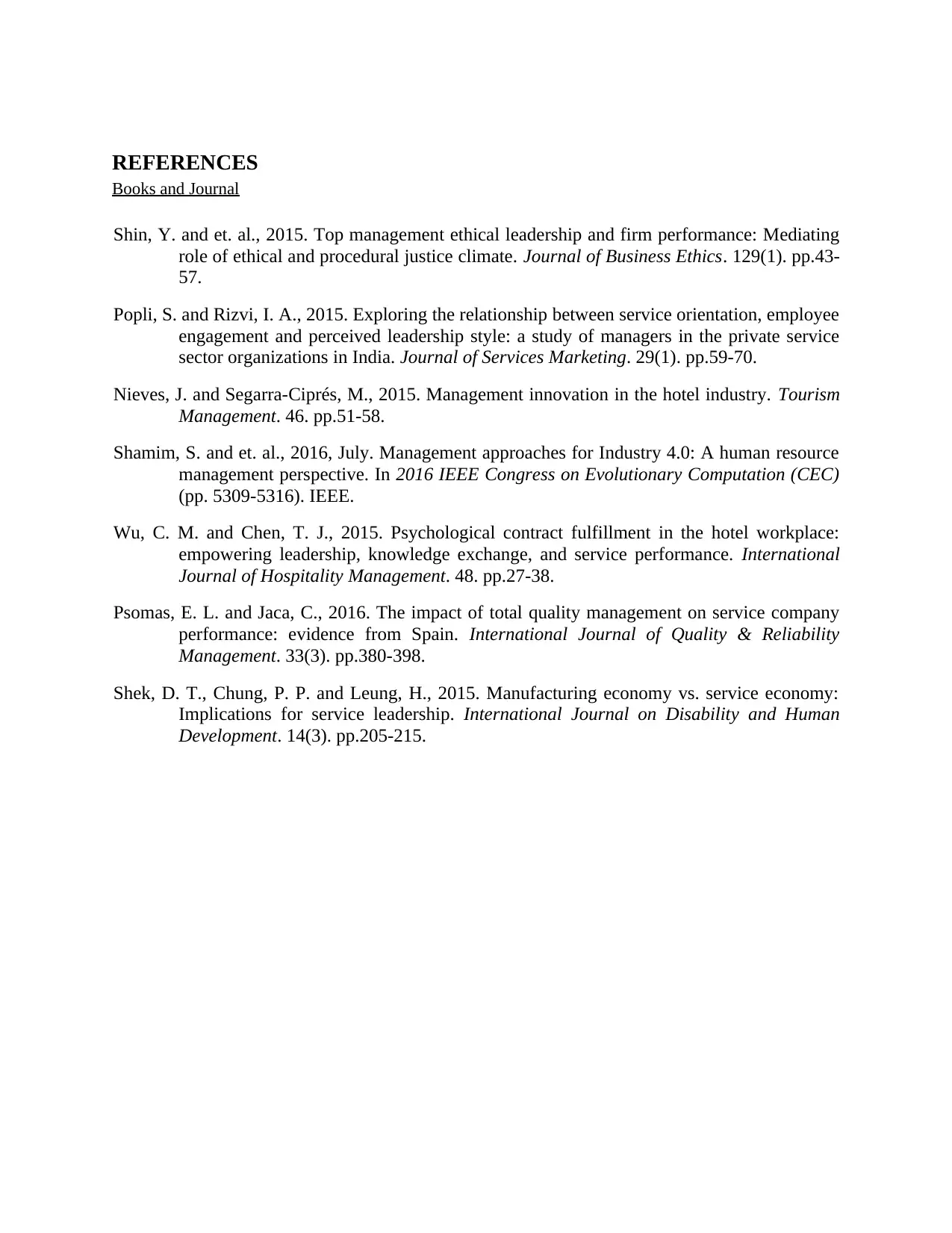
REFERENCES
Books and Journal
Shin, Y. and et. al., 2015. Top management ethical leadership and firm performance: Mediating
role of ethical and procedural justice climate. Journal of Business Ethics. 129(1). pp.43-
57.
Popli, S. and Rizvi, I. A., 2015. Exploring the relationship between service orientation, employee
engagement and perceived leadership style: a study of managers in the private service
sector organizations in India. Journal of Services Marketing. 29(1). pp.59-70.
Nieves, J. and Segarra-Ciprés, M., 2015. Management innovation in the hotel industry. Tourism
Management. 46. pp.51-58.
Shamim, S. and et. al., 2016, July. Management approaches for Industry 4.0: A human resource
management perspective. In 2016 IEEE Congress on Evolutionary Computation (CEC)
(pp. 5309-5316). IEEE.
Wu, C. M. and Chen, T. J., 2015. Psychological contract fulfillment in the hotel workplace:
empowering leadership, knowledge exchange, and service performance. International
Journal of Hospitality Management. 48. pp.27-38.
Psomas, E. L. and Jaca, C., 2016. The impact of total quality management on service company
performance: evidence from Spain. International Journal of Quality & Reliability
Management. 33(3). pp.380-398.
Shek, D. T., Chung, P. P. and Leung, H., 2015. Manufacturing economy vs. service economy:
Implications for service leadership. International Journal on Disability and Human
Development. 14(3). pp.205-215.
Books and Journal
Shin, Y. and et. al., 2015. Top management ethical leadership and firm performance: Mediating
role of ethical and procedural justice climate. Journal of Business Ethics. 129(1). pp.43-
57.
Popli, S. and Rizvi, I. A., 2015. Exploring the relationship between service orientation, employee
engagement and perceived leadership style: a study of managers in the private service
sector organizations in India. Journal of Services Marketing. 29(1). pp.59-70.
Nieves, J. and Segarra-Ciprés, M., 2015. Management innovation in the hotel industry. Tourism
Management. 46. pp.51-58.
Shamim, S. and et. al., 2016, July. Management approaches for Industry 4.0: A human resource
management perspective. In 2016 IEEE Congress on Evolutionary Computation (CEC)
(pp. 5309-5316). IEEE.
Wu, C. M. and Chen, T. J., 2015. Psychological contract fulfillment in the hotel workplace:
empowering leadership, knowledge exchange, and service performance. International
Journal of Hospitality Management. 48. pp.27-38.
Psomas, E. L. and Jaca, C., 2016. The impact of total quality management on service company
performance: evidence from Spain. International Journal of Quality & Reliability
Management. 33(3). pp.380-398.
Shek, D. T., Chung, P. P. and Leung, H., 2015. Manufacturing economy vs. service economy:
Implications for service leadership. International Journal on Disability and Human
Development. 14(3). pp.205-215.
1 out of 7
Related Documents
Your All-in-One AI-Powered Toolkit for Academic Success.
+13062052269
info@desklib.com
Available 24*7 on WhatsApp / Email
![[object Object]](/_next/static/media/star-bottom.7253800d.svg)
Unlock your academic potential
Copyright © 2020–2025 A2Z Services. All Rights Reserved. Developed and managed by ZUCOL.




